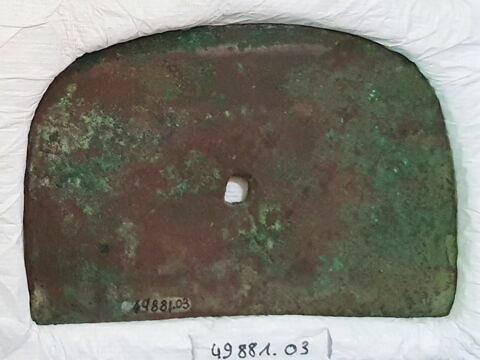Fullscreen Modal
Download
Next
Previous
Download image
hache semi circulaire à trou de fixation
-2900 / -2700 (Khâsékhemouy)
Place of discovery : tombe de Khâsékhemouy
E 11025 6
Département des Antiquités égyptiennes
Currently on display at the Musée du Louvre
Salle 634
Aile Sully, Niveau 1
- Inventory number
- Numéro principal : E 11025 6
- Collection
- Département des Antiquités égyptiennes
- Object name/Title
- Dénomination : hache semi circulaire à trou de fixation
- Description/Features
- lame ; manche manquant
- Dimensions
- Largeur : 13,3 cm ; Longueur : 10,8 cm
- Materials and techniques
- Matériau : cuivre
- Date
- Khâsékhemouy (contexte de fouilles) (-2900 - -2700)
- Date of discovery
- 1896-1897
- Place of discovery
- tombe de Khâsékhemouy (Oumm el-Qaab->Abydos->Haute Égypte)
- Collector / Previous owner / Commissioner / Archaeologist / Dedicatee
-
Amélineau, Émile Clément, Fouilleur/Archéologue
- Acquisition details
- achat en vente publique
- Acquisition date
-
date de comité/commission : 07/01/1904
date du conseil : 01/02/1904
date de l'arrêté : 29/03/1904 - Owned by
- Etat
- Held by
- Musée du Louvre, Département des Antiquités égyptiennes
- Current location
-
Sully, [AE] Salle 634 - L'époque thinite, Galerie d'étude, Vitrine ge 2
- Mode d'acquisition
- achat en vente publique
- Materials
- cuivre
- Description/Features
- lame - manche manquant
- Period
- Khâsékhemouy
- Places
- tombe de Khâsékhemouy
-
Odler, Martin, Copper in Ancient Egypt. Before, during and after the Pyramid Age (c. 4000-1600 BC), Culture and History of the Ancient Near East 132, Leyde, Brill, 2023, p. 346, 352, fig. 148
-
Couton-Perche, Nathalie, Les armes de l'Égypte ancienne. La collection du musée du Louvre, [Musée du Louvre, Paris], Paris, Louvre éditions / éditions Khéops, 2021, p. 69, p. 69, n° 38 recto,verso
-
Davies, W. Vivian, Tools and Weapons I, Axes, 7, Axes, [Catalogue of Egyptian Antiquities in the British Museum VII], Londres, British Museum Press, 1987, p. 73
-
Vercoutter, Jean, « Les poids de Mirgissa et le "standard-cuivre" au Moyen Empire », dans Endesfelder, Erika ; Priese, Karl-Heinz ; Reineke, Walter-Friedrich ; Wenig, Steffen (dir.), Ägypten und Kush: Festschrift Fritz Hintze zum 60. Gerburstag gewidmet, Berlin, Zentralinstitut für alte Geschichte und Archäologie, (Schriften zur Geschichte und Kultur des Alten Orients ; 13), 1977, p. 437-446, p. 444 note 57
-
Hours, Madeleine ; Michel, Félix, « Scientific Methods in the Study of the Metallurgy of Antiquity at the Louvre », dans Young, William F. (dir.), Application of Science in Examination of Works of Art: Proceedings of the 3rd International Seminar, June 15-19, 1970, Boston, 1974, p. 67-72, passim, n° 1
-
Antiquités égyptiennes trouvées à Abydos [collection Amélineau], [Vente Drouot, 1904, 08-09/02], p. 19, n° 111
-
Amélineau, Emile, Les nouvelles fouilles d'Abydos. Seconde campagne 1896-1897. Compte rendu in extenso des fouilles, description des monuments et objets découverts, Paris, Ernest Leroux, 1902, p. 255-266, pl. XVIII, n° 4
Description
Physical characteristics
Places and dates
History
Location of object
Index
Comparative literature
- Odler, Martin ; Kmošek, Jiří, Invisible Connections- An archaeometallurgical Analysis of the Bronze Age Metalwork from the Egyptian Museum of the University of Leipzig, Oxford, Archaeopress (31), (Archaeopress Egyptology 31), 2020, p. 29, fig. 20
- Rummel, Ute (dir.), Meeting the past : 100 years in Egypt, German archaeological Institute Cairo 1907-2007. Catalogue of the special exhibition in the Egyptian Museum in Cairo, cat. exp. (Le Caire, Musée égyptien, 2007), Le Caire, Deutsches Archäologisches Institut, 2007, p. 88, n° 71 gauche
- Quibell, James Edward, Catalogue général des Antiquités Egyptiennes du Musée du Caire (CGC), N° 11001 - 12000,Archaic Objects vol. 1, Le Caire, Institut français d'archéologie orientale (IFAO), 1905, p. 279-280
- Quibell, James Edward, Catalogue général des Antiquités Egyptiennes du Musée du Caire (CGC), N° 11001 - 12000,Archaic Objects, 2, Le Caire, Institut français d'archéologie orientale (IFAO), 1905, pl. 59





